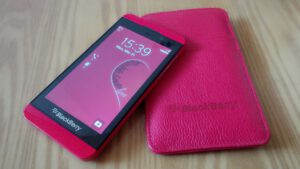
In its prime BlackBerry’s mobile phones were coveted as a status symbol. The company had hit its peak at 80 million active users and a 50% control over the US smartphone market. Their instant communication features were so compelling they even earned themselves the nickname “Crackberry”. These days BlackBerry may no longer control the global smartphone market, but they haven’t given up – they’ve pivoted their focus entirely into cybersecurity for enterprises.
Q2 2020 hedge fund letters, conferences and more
BlackBerry’s Early Days
Blackberry first got its start in March of 1984 under the name of Research in Motion (RIM), a consulting business based out of Waterloo, Ontario. Before the company introduced its first official BlackBerry device in 1999, RIM dabbled in a variety of projects including a local network for IBM and an Emmy/Academy Award-winning film editing system called DigiSync.
Fast forward to 2013 when RIM officially rebrands the company to BlackBerry Ltd. At this time BlackBerry has just hit its peak even while struggling to balance satisfaction between their split demographic of mobile corporate users and young students that admired the BlackBerry for its free messaging service.
Soon after, a failure to successfully respond to growing trends in the smartphone market – namely the rise of touchscreens and cameras – saw BlackBerry being steadily overtaken by Apple and Android. By the time BlackBerry responded with their own touchscreen phone, it was much too late.
BlackBerry pivots into cybersecurity
“Our Mission – To be the world’s leading provider of end-to-end mobility solutions that are the most secure and trusted.” – BlackBerry
While BlackBerry held a foothold for a while in the corporate world by differentiating its mobile phones through their heightened security features, its competitors have since caught up. The iPhone has greatly bolstered its security features and Samsung’s Knox has established Android as a viable enterprise solution for mobile security.
After several attempts to reclaim their throne in the world of smartphones, BlackBerry realized a need for change. In the last quarter of 2016, they dropped to a virtual 0% market share in the global smartphone marketplace and officially announced that they would no longer make smartphones.
Moving on from their smartphone-oriented past, BlackBerry switched its focus to software and enterprise services. BlackBerry transformed themselves into a software security company with the aim of setting the standard for cybersecurity in the realm of the internet of things (IoT), artificial intelligence (AI), and other innovative endpoints seen in both enterprise and consumer environments.
They’ve acquired several related companies including cryptographic and hardware key provisioning company Certicom in 2009, embedded operating system technology company QNX in 2010, mobile security provider Good Technology in 2015, UK cybersecurity consultancy Encription in 2016, and AI-based threat detection company Cylance in 2018. BlackBerry appears to be leveraging this diverse portfolio of cybersecurity companies to continue fueling their pursuit into the space.
In 2019 they announced the formation of The BlackBerry Advanced Technology Development Labs, better known as BlackBerry Labs. This new unit of their business is entirely dedicated to research and development of innovative cybersecurity technologies. BlackBerry Labs began by exploring methods of using AI to improve cybersecurity in the automotive industry, a critical path for a major enterprise to take considering the rising popularity of IoT-enabled vehicles.
Where is BlackBerry now?
These days Blackberry is still going on strong in the realm of cybersecurity. In June of 2020, they announced through a press release that their QNX software is embedded in over 175 million cars, an increase of 25 million cars since their report in June 2019. According to their press release their automotive customer base includes Audi, BMW, Ford, GM, Honda, Hyundai, Jaguar Land Rover, KIA, Maserati, Mercedes-Benz, Porsche, Toyota, and Volkswagen.
The QNX operating system continues to be adopted for “advanced driver assistance, digital instrument clusters, connectivity modules, handsfree, and infotainment systems that appear in car brands”. QNX has also found a home in powering hydroelectric plant control systems, wind turbines, as well as the command and data handling subsystem for the International Space Station.
BlackBerry has worked to position itself as a strong contender in the corporate cybersecurity space by offering cybersecurity consultancy, licensing its intellectual property, and providing security-focused software solutions.
All of this isn’t to say that BlackBerry has given up on smartphones entirely. Until August 31, 2020, they have been licensing their brand to TCL communication, who will now be focusing on producing their own branded phones. Recent announcements have even shown that BlackBerry will be partnering with FIH Mobile and OnwardMobility to launch a new 5G-enabled BlackBerry Android phone in the first half of 2021.
Conclusion
While they are currently nowhere near as prevalent as they were in their prime, BlackBerry has created a space for themselves in the world of cybersecurity. Their push towards establishing the precedent for securing innovative technologies. While it remains to be seen if BlackBerry becomes the leader in the automotive and IoT security space, their strategic acquisitions and focus on innovation will provide them with the foundation they need to further their foothold as the security of emerging technologies becomes increasingly paramount.
The post BlackBerry’s Push Into Enterprise And Cybersecurity appeared first on ValueWalk.
